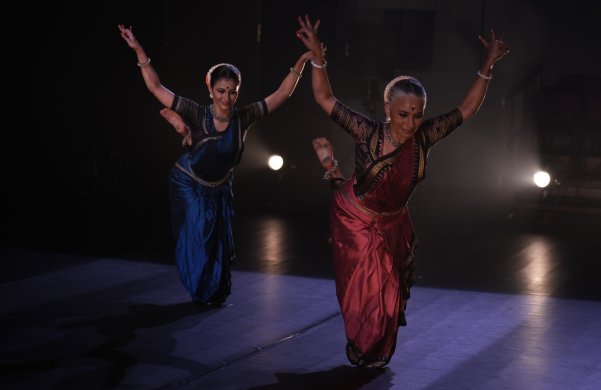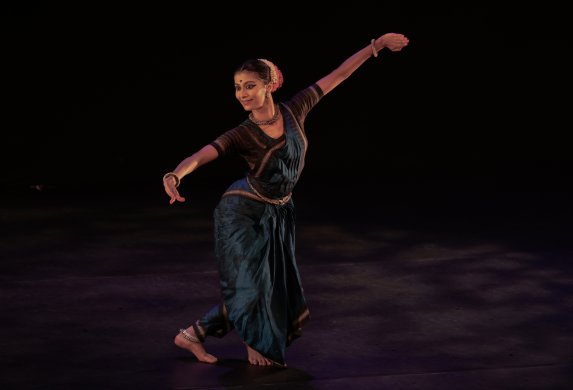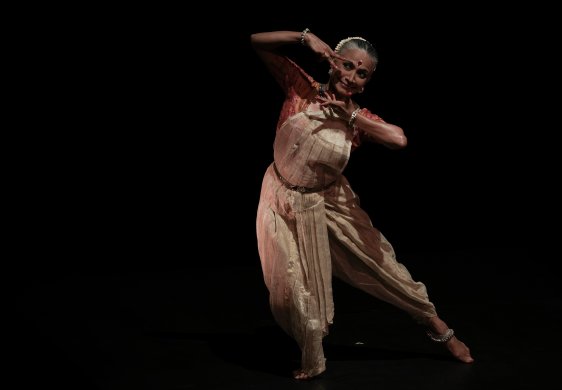
|   |

|   |
Dvikā - Guru and Shishya cast a spell in groundbreaking Odissi recital - Sumana Sachidananda e-mail: sumanas29@gmail.com Photos: Eesha Pinglay November 14, 2024 'Dvikā' presented by Bijayini Satpathy and her disciple Prithvi Nayak was nothing short of a series of indescribable, goosebump moments that we experienced at the NCPA on November 7, 2024. 'Dvikā' as the name suggests, was a presentation by two breathtakingly beautiful artistes, consisting of duets and solos. It was heartening to see the disciple being given a prominent solo presence on stage, which tells of the selfless attitude of the Guru. Swami Vivekananda had said, "He is an Acharya through whom the divine power acts", and that "intense love for the Guru makes rapid growth possible, he connects us with the internal Guru". The Guru- Shishya equation we witnessed on stage embodied these statements.  Bijayini Satpathy and Prithvi Nayak in 'Doha' Dvikā celebrated the concept of duality in the realms of divinity, humanity and mortality. From exploring the illusionary nature of the cosmos and the intense longing of the mortal for the supreme, to depicting the final liberation of the soul from the physical body, this performance took the rasikas on an intense spiritual journey. The first piece explored the true essence of prayer, which reflects a combination of solemn rituals and playful gestures. This was depicted through distinct movements in the rich Odissi vocabulary, replete with dynamic exchanges between stillness and movement. Supported largely by energetic nritta bols, the piece incorporated a couplet by the great 18th century Urdu poet Mir Taqi Mir who is referred to as Khuda-e-Sukhan (God of poetry) - "Le Saans bhi ahista ki nazuk hai bahut kaam, Afaaq ki is kargah-e-shishagari ka". Here, the poet tells the seeker to breathe softly as the glasswork/ mirrorwork of the universe is fragile. Such a profound thought, which reveals the transient nature of the cosmos, where everything is a mirage. The dancers were able to switch from total elation to utter quietude, and vice-versa in a heartbeat. Bona fide yoginis both of them! Not just that, they always complimented each other in movement while utilising the entire stage. Imagine watching a colourful butterfly hover around a bright marigold flower. You would want to observe the butterfly and marigold individually, yet capture their interaction. That's exactly how this piece was! The second piece called 'Call of Dawn' explored the sweet sentiment of anticipation. The first part was presented by Bijayini, based on Kazi Nazrul Islam's song "Ahirini". Ahirini in Bangla means milkmaid/ female cowherd. The young maiden asks to be saved from the blazing form of the fierce Lord Shiva, as she longs to be with the pleasant, dark complexioned Lord Krishna. The starkly contrasting personalities of Shiva and Krishna were brought to life impeccably. Bijayini is the dancer who has mastered in equal measure the agility of the limbs and the fluidity of the face. She can communicate with just her eyes.  Prithvi Nayak in 'Chakravaaka Pallavi' The second part was presented by Prithvi. It was an abstract nritta composition - Chakravaaka Pallavi. As per ancient scholars, the Chakraavaka birds (lovers) typically get separated at night, and long to be reunited at the call of dawn. The predominant bhava of hope was manifested delightfully by Prithvi in this pure dance piece. The rhythmic wizardry of choreographer Bijayini needs a special mention here. Prithvi did complete justice to the choreography which included fast-paced chaaris (lower body movements), intricate hand gestures and complex footwork. Her name is Prithvi but she reminds of Ganga, as she flows effortlessly!  Bijayini Satpathy in 'Naino' After this, Bijayini was back, in white attire. She looked serene and stunning, but her dance stirred our hearts so deep. She presented Kabir's poetry, which spoke of 'piya' (the beloved) and 'naino' (the eyes). The very first strains of the Bazouki (a type of a lute which sounds similar to the mandolin) itself put one in a trance. Music has the power to transport us to a different realm. Bindhumalini is a genius who is creative yet so grounded in the basics of Indian classical music. Kabir says, "Naina antar aav tu, nain jhaapi tohi leu, Na mein dekhu aur ko, na tohi dekhan deu". The poet likens the eyes to doors, and pleads with the supreme to enter his innermost core through these 'doors'. He promises to close the eyes after, as he seeks nothing else. He says he will neither look at anyone else, nor let anyone look at his beloved/ supreme. Every tradition speaks of uniting with the divine, whether Sufi or Advaita. The yearning of the seeker for the divine was portrayed so powerfully by Bijayini, that I had goosebumps throughout. The innate sringara element in Kabir's poetry woven through clever metaphors of love, transformed into irresistible, lyrical Odissi. After a long time, I could experience silence in dance. When all movement, sound and expression cease to exist, then emerges the Sattva - the pure, meditative state. This tranquillity was so palpable in the theatre, it almost felt like even a slight nod or glance here and there by a rasika would disturb everyone's state of mind. The dancers concluded with 'Vimukthi', the dance of liberation. In our culture, death signifies that which is inevitable, that which leads one from form to formless. This piece was based on the lines of Kabir where he says that when his heart dances, the planets and stars dance along. This was the thrilling finish to a magnificent evening of Odissi. Guru and Shishya, in unison, danced as if time were their playground. No fatigue, only ecstasy. Words like enthralled, captivated, bewitched, and so on do not suffice, to enunciate what the rasika truly experienced. Dvikā was so traditional yet so unique! (P.S. I was surprised to see highly simplified aharya. No maangtika, maathapatti / allaka, jhumkas, silver belt, or ghunghroos! The dancers looked exquisite sans all of this, but I missed the sound of the ghunghroos.)  Sumana Sachidananda is a Kathak dancer based in Mumbai. She is an MBA from ISB Hyderabad and has also trained in Carnatic music. She holds a Senior Diploma in Kathak from Bharatiya Vidya Bhavan and is a DD graded artist. |